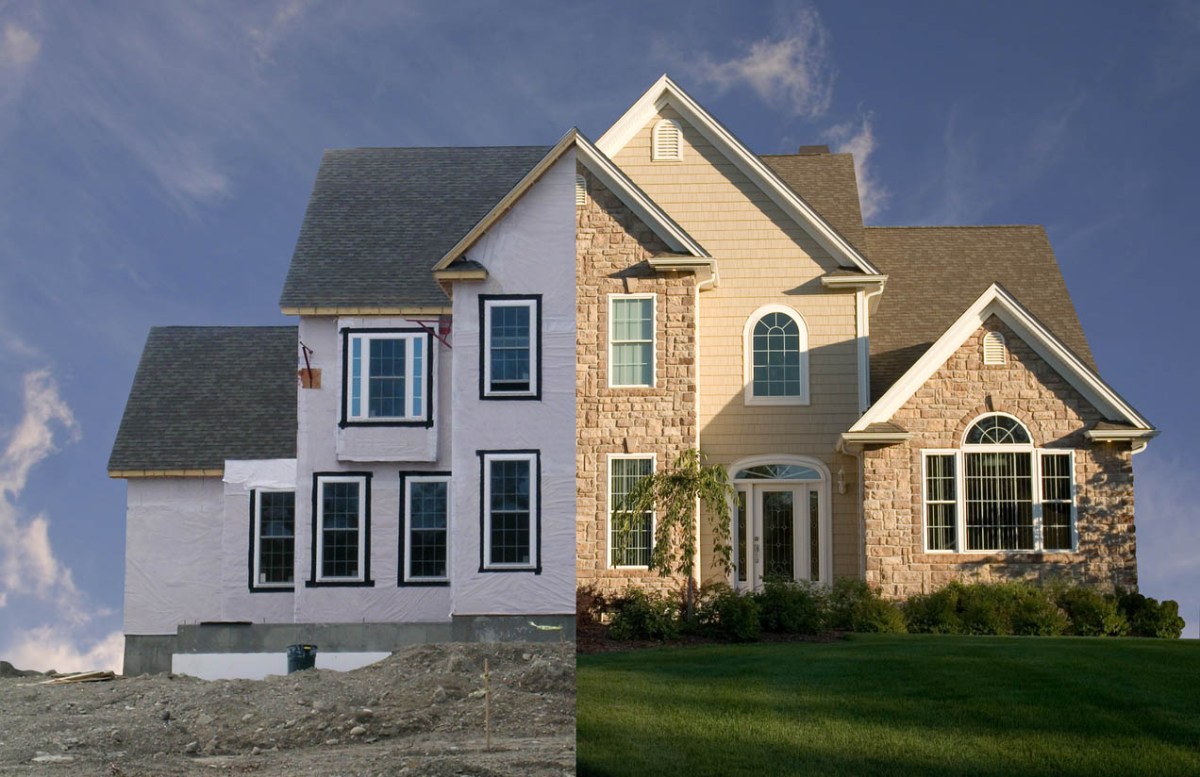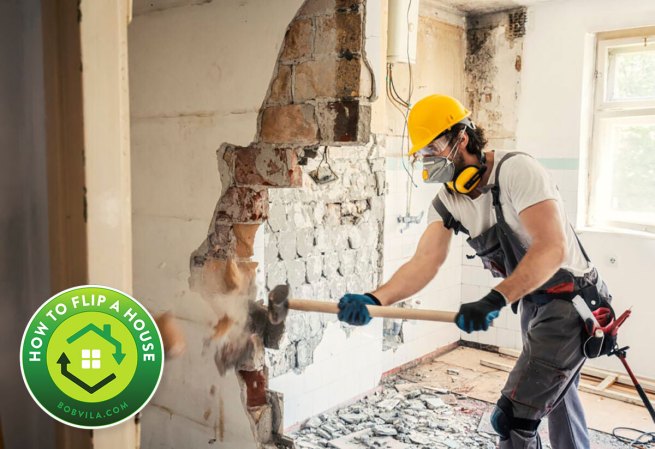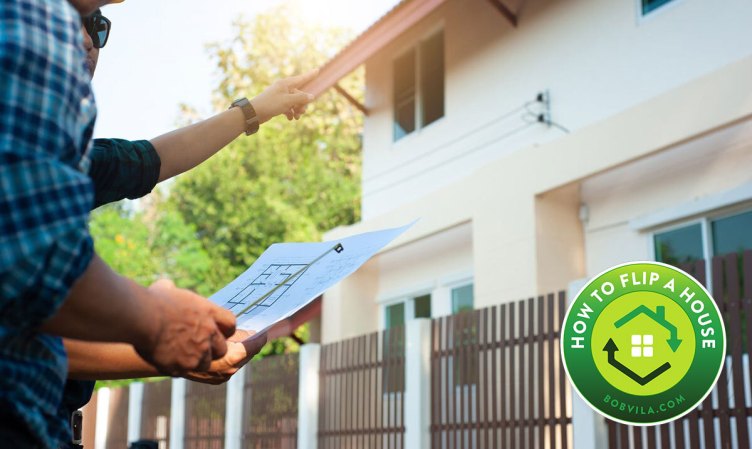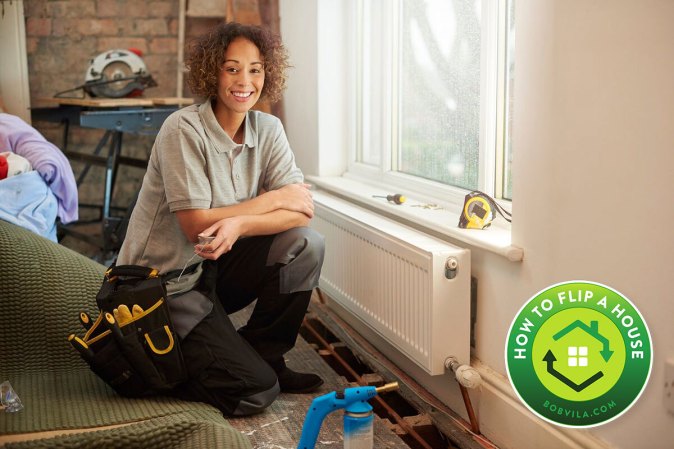We may earn revenue from the products available on this page and participate in affiliate programs. Learn More ›
- Typical Range: $17,920 to $78,082
- National Average: $47,903
Optimistic real estate investors often enter a house flip with the hope of making a ton of cash in just a short time. When done correctly, this outcome is certainly possible. But before diving in, potential flippers need to ask themselves an important question. How much does it cost to flip a house?
There’s a lot more to consider than just the purchase price. Insurance, inspections, and of course all the projects that go into flipping a house can quickly add up. That’s why there’s such a wide range in house flipping costs. According to Angi and HomeAdvisor, investors can expect to pay between $17,920 and $78,082 for a full renovation to flip a home, with a national average cost of $47,903. The final price tag depends on a variety of factors, including a home’s age and style and how many different types of contractors need to be brought in to refinish the home.
This guide will cover the factors that go into the cost to flip a house, the pros and cons of house flipping, and how investors can save money on a flip.
Factors in Calculating the Cost to Flip a House
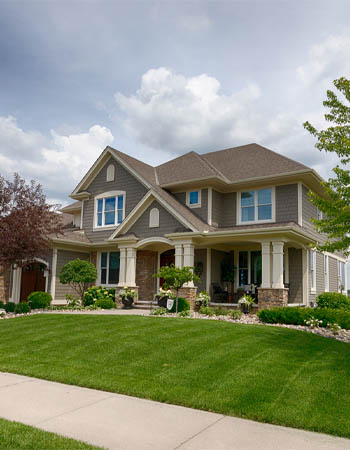
Flipping houses takes grit and, in most cases, an awful lot of cash. There’s more to calculate than purchase price and materials, and all the different characteristics of a home play a role in estimating the final number. Being able to accurately calculate how much it costs to flip a house is often the difference between barely breaking even and making a sizable profit. The following are the top factors investors need to consider when calculating the cost to flip a house.
Purchase, Insurance, and Ownership Costs
How much money do you need to buy a house? The cost of property acquisition is more than a home’s asking price. Potential flippers need to consider taxes, insurance, title fees, financing fees, and additional acquisition costs in addition to the home’s sale price. For example, the average cost for an insurance policy to cover a vacant or unoccupied home costs $1,842 annually.
There are many different numbers to crunch when deciding whether a potential flip is a wise investment, and it can be difficult to predict them all. It’s wise to leave plenty of financial padding when budgeting for a flip. That’s why many flippers follow something called the 70 percent rule. In general, flippers will want to avoid purchasing homes that cost more than 70 percent of the after-repair value, or ARV (the estimated value of a property after a finished flip), minus the cost of repairs.
For example, an investor may find a home in a sought-after neighborhood that is on the market for $225,000. After some research into the market, they believe they could sell the home for $300,000 after fixing it up. They would then consult a general contractor to get an estimate of how much repairs would cost; in this case, they find that the total repair cost would be $30,000. Using the 70 percent rule, the math would look something like this:
(300,000 × .70) − 30,000 = 180,000
With the property’s asking price at $225,000, the investor would likely pass on the opportunity unless they could get the seller to accept $180,000. In this case, purchasing the home for its asking price and flipping it could result in the investor losing money. They could either try to negotiate the price down to $180,000 or keep looking for a different property to flip with numbers that line up better with the rule of 70.
Home Size
A home’s size plays a large role in how much it will cost to flip. Generally speaking, the larger a house is, the more rooms it has. With more rooms come more walls, windows, doorways, and doors, all of which are potential projects.
When trying to estimate the cost to flip a house by size alone, investors can expect to pay between $10 and $60 per square foot for renovations. However, investors who choose high-end materials or top-of-the-line appliances can expect this number to shoot up closer to $150 per square foot. Investors will want to keep in mind that they may not need to renovate every square foot of the property; there may be some parts of the home that are salvageable but just need a good cleaning. That’s why it’s important for buyers to note how long it’s been since previous bathroom renovations or kitchen overhauls. Being able (or unable) to cross off a fraction of a home’s square footage that requires renovation can help portray a more accurate cost.
Home Type
The type of home being considered for a flip is important when estimating the total investment cost. Some types of homes are traditionally smaller or larger, while other types of homes may have HOA guidelines that a flipper must adhere to. For example, an apartment building may require the same basic updates expected in a flip but on a smaller scale, such as a bathroom overhaul and a brand- new kitchen. Flippers can expect to pay between $25 and $40 per square foot for renovations in an apartment building.
Condos are similar, but flippers often need to plan according to homeowner association (HOA) rules. This often results in a higher budget with typical renovation costs of $70 to $100 per square foot. Townhouses can also have HOA rules for flippers to follow, though renovations tend to be more affordable with a range between $10 and $35 per square foot.
Renovating row houses often involves finding matching materials for connecting homes, resulting in a flipping price range of $25 to $75 per square foot. Finally, mobile homes are easier to estimate by project and come with a typical renovation cost range of $10,000 to $30,000, mainly dependent on square footage.
Home Style
Certain home styles may warrant a higher flipping budget than others. To meet expectations of potential buyers, it’s best for flippers to stick with one style type for a cohesive aesthetic. Therefore, it’s important for flippers to choose a style that will fit their budget from the home’s front door to every corner of every room.
Farmhouse is a popular home style with many buyers. On average, upgrading a home to this rustic and cozy look costs between $10 and $50 per square foot. Flipping a Victorian home often involves preserving a historical home, which may require purchasing time period–appropriate materials that can be more expensive. Victorian-style homes often need to be brought up to code or involve structural upgrades along with cosmetic changes. This can all add up to a higher flipping cost, and on average, it costs between $20 and $200 per square foot to renovate a Victorian home to flip.
Not all historical homes are Victorian, though, and restoring any type of historic home often comes with a higher price range for flippers. A typical historical home flip costs between $100 and $200 per square foot. The good news is that many historical homes, especially if they’re listed on the National Register of Historic Places, qualify for grants that can help cover the cost of renovations.
Home Age
When it comes to flipping homes, the property’s age should be taken into account. A newer house is likely to be in better overall shape, which minimizes the chance of expensive upgrades or projects such as bringing electrical work up to code. Older homes can incur higher labor costs if contractors have to deal with health hazards such as lead paint or asbestos. New homes are built with safer materials that don’t pose health risks to contractors.
Investors shouldn’t rely on a home’s age alone though to determine whether it carries a high or low potential for profit. A poorly constructed new home may require more work than an older home that’s already gone through a few rounds of renovations. The best way to use a home’s age to help estimate its flipping cost is to also explore its history.
Home Condition
A home’s condition plays a huge factor in its flipping cost. A house that’s in overall good condition is likely to need cosmetic updates, such as new floors, updated paint colors, and replaced trim work throughout. A house flipper can expect to pay around $20,000 for a full renovation of a home in good condition.
But a home that’s battered and beaten, either due to neglect, vacancy, or disaster, is likely to require a higher flipping budget. Investors can expect to put in up to $100,000 on restoring a home in poor condition. For oversize or historical homes, this number could be even higher.
Room Types
A flipper can get a better idea of what they’ll need to budget for by splitting the rooms in a home into two categories. Wet rooms are those with water running to them; examples include kitchens, bathrooms, and laundry rooms. Dry rooms do not have water sources and include bedrooms and living areas. Generally speaking, wet rooms cost more to renovate than dry rooms.
For example, bathrooms have an average price range of $3,000 to $25,000 to renovate. Kitchens start at $6,000 and can soar into six-figure remodels. Utility rooms also start at $6,000 to renovate. A bedroom is a dry room so even though it starts at a higher minimum of $10,000 to renovate, the cost will rarely exceed $15,000. A living room typically costs between $5,000 and $10,000 to renovate.
Knowing how many of each room type a house has and then breaking down the numbers accordingly can help a house flipper determine their budget while helping them stay on track without exceeding costs.
HVAC Repair or Replacement
Heating, ventilation, and air-conditioning repair or replacement are important factors to consider when determining a house-flip budget. An HVAC unit typically costs between $500 and $7,200, though the exact cost depends on brand, labor, and the specifics of the installation.
Central air installation costs between $3,800 and $7,600, while a furnace install costs between $2,800 and $6,800. A heat pump replacement or installation costs between $4,200 and $7,500, while replacing ducts and vents costs between $500 and $2,100.
Appliance Replacement
Replacing appliances is a necessary, albeit sometimes tricky, process of a house flip. While leaving appliances as is can leave potential buyers disappointed, going overboard with upgrades can leave less room for profit.
Appliances cost anywhere from $200 to $10,000, though this number can increase with high-end brands. It’s wise to spend more on the appliances buyers notice the most, such as stoves and refrigerators, and be more modest (without being cheap) on dishwashers or washing machines.
For basic or discount appliance models, flippers can expect to pay between $100 and $2,000. For high-end models, the price range grows to between $300 and $5,000. Energy Star appliances cost between $200 and $3,500, while custom built-in appliances start at $1,000 and can approach $10,000 apiece. But when they make sense in a design, expensive appliances can help secure top dollar from a buyer.
Labor
When flippers are working with multiple contractors, there are several different price ranges labor costs can fall into. In general, labor costs for house renovations typically fall between $20 and $150 per hour. This range can be narrowed down by profession to make it easier to anticipate costs.
More specifically, architect fees range between $125 and $250 per hour, while interior designers charge between $50 and $200 per hour. Kitchens can often benefit from an expert who can weigh in on functionality and design, so investing in a kitchen designer can be a wise choice. These pros tend to charge between $65 and $250 per hour.
Painters charge $20 to $50 per hour, while plumber rates range from $45 to $200 per hour. Electricians charge between $50 and $100 an hour, and an hourly HVAC technician charge can range from $50 to $150. When it comes to the cost to renovate the exterior of a home, landscape designer fees run between $50 and $150 per hour.
Geographic Location
A home’s location can greatly influence its total cost to flip. In fact, homes renovated in a densely populated area can cost up to 40 percent more to flip than those in more rural areas.
For flippers shopping by location, here are a few numbers to keep in mind. Homes flipped in Jacksonville, Florida, are the least expensive, costing $15 to $60 per square foot. Homes in Phoenix, Arizona; Los Angeles, California; and Denver, Colorado, all fall within a range of $20 to $100 per square foot to flip. Finally, homes in Houston, Texas; New York City; and San Francisco, California, all have the highest renovation costs. On average, homes in these locations cost between $25 and $150 per square foot to flip.
On a final note, location alone isn’t enough to determine whether a flip is a good investment or not. Investors should also remember that homes located in more densely populated areas, though more expensive to flip, also tend to sell for more than those in less populated regions of the country.
Selling Costs
Selling costs, or closing costs, are another factor to keep in mind when flipping a home. These additional costs include transfer taxes, property taxes, property insurance, title company fees, and title insurance.
As a general rule of thumb, house flippers can expect selling costs to equate to about 2 percent to 5 percent of the home’s final sale price. Selling costs can be negotiated, which is smart for flippers to attempt, since selling costs can cut into profits both when the house is purchased and when it’s sold. In many cases, only the buyer pays closing costs. But there are scenarios where sellers may have to pay a portion of these costs as well. Who pays what is determined in the sales contract, not at the closing table, so flippers looking minimize their selling costs will want to be sure those items are clearly defined in the contract.
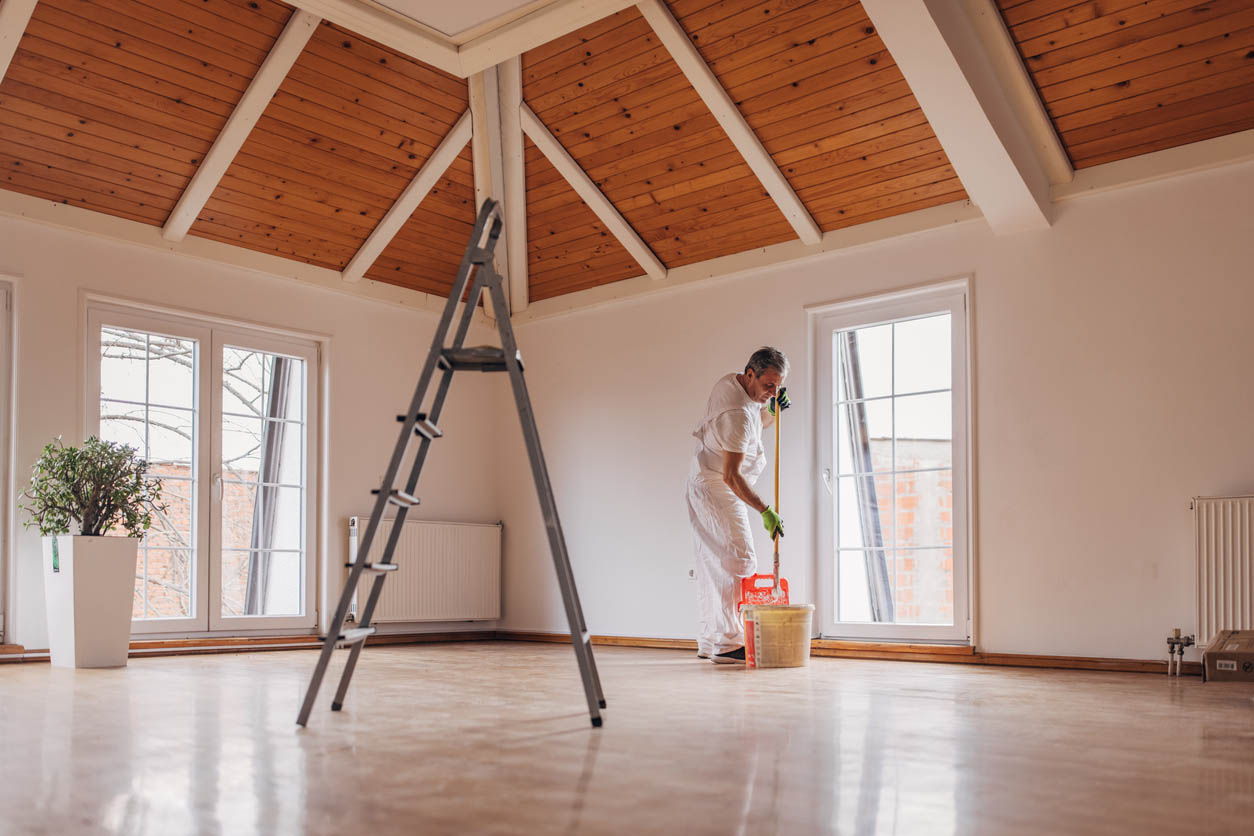
Additional Costs and Considerations
The following additional costs and considerations don’t apply to every home flip. But investors should still be aware of them to avoid surprises as they move through their renovation timeline.
Loan Costs
There are a few different ways to fund a house flip; it’s not uncommon for a veteran investor to be able to pay cash for a home and to avoid additional costs and fees. But for new flippers or those taking on a home worth more than they’re willing or able to pay for in cash, an asset-based loan is usually the answer.
The best loans for flipping houses are short-term and secured by an asset, including property. It’s typically easier to qualify for an asset-based loan because the collateral serves as security to the lender. But the caveat is that interest rates are often higher than traditional bank loans, with most asset-based loans carrying an APR (annual percentage rate) of 9 percent to 15 percent. Despite the higher interest rates, many flippers still flock to asset-based loans over traditional ones since banks are reluctant to fund flips due to the risk involved.
No matter the type of loan, flippers should always consider the interest rates when estimating the potential for profit in a flip.
Permits
When it comes to flipping houses, a permit is almost always required. In fact, the homeowner can expect the need for multiple permits before a flip can begin. Issued by local government agencies, a permit is an official approval that allows a home improvement project to proceed. Permits are issued to ensure projects are done safely and comply with local standards, since even experienced contractors can make mistakes. Homes being renovated to flip need to have permits for the work being done to make sure they’re up to code and current safety standards.
When tackling a house flip, investors can expect to pay between $400 and $1,800 on average for permits. Contractors may include the cost of obtaining permits in their project bid, which can mean one less task for a home flipper to worry about.
Interior vs. Exterior Upgrades
Some home flips involve changes to the interior only, while others focus mainly on the exterior. Plenty are a combination of both areas, with each space incurring different average renovation costs.
Flippers can expect exterior work to cost between $5,000 and $15,000 on average, while the cost for interior upgrades depends heavily on the type of space. For example, updating a bedroom costs around $5,000, while renovating a kitchen costs between $30,000 and $60,000.
Home Additions
A home addition can be a pricey add-on with a typical range of $22,500 to $80,100. But before agreeing to or disregarding an addition, flippers should know they can be as affordable as $5,000 or as expensive as $150,000. The final cost depends on the size of the addition, the materials chosen, and what the space will be used for.
For example, a kitchen addition is likely to cost more than a bedroom addition. A kitchen is traditionally larger in size, has appliances and more finishes, and involves plumbing and more expensive outlets compared to a basic bedroom without an en suite bathroom.
Costs per Type of Contractor
A successful flip involves contractors, and typically quite a few different types. Knowing what to expect each variety to charge in labor can help keep a flip on budget. It should be noted that not every flip will require the assistance of every type of contractor listed below, but getting by with only a general contractor is rare as well.
General Contractor
A general contractor is the person who takes on the responsibility of overseeing a construction project. This person usually works with subcontractors and makes sure that everything is completed according to a schedule.
A general contractor for house flipping will make sure that the job gets done to specifications by overseeing every aspect of the project. They will make sure that all of the necessary renovations are done and that they are completed in a timely manner. General contractor fees typically add up to between 10 percent and 20 percent of the total project price.
Architect
Not all home flips require the services of an architect. But before deciding to go at it alone, flippers should consider a couple of things. Architects have an understanding of how buildings work and what is needed for a house flip. They can also help with building codes and other regulations. Sometimes, it is worth it to hire an architect for a house flip just for the peace of mind they can provide during the creation and implementation of a design. On average, architects charge between $125 and $250 per hour.
Structural Engineer
A structural engineer is a professional who is qualified to design, inspect, and oversee the construction of buildings. The role of a structural engineer is to review the work of other engineers and design structures that are safe and secure. A structural engineer may be required for a house flip if there are structural issues with the property that need to be addressed, or if the flipper wants to knock down a load-bearing wall or is planning an addition. On average, the services of a structural engineer for a house flip cost between $350 and $900.
Interior Designer
Interior designers are professionals who design the layout and style of interior spaces that are used for living, work, or other activities. These professionals can help with all aspects of a house flip and can help a flipper decide on the best layout for a space and then provide a design plan. They can also help determine what pieces of furniture to buy to fill each room and how to arrange them appropriately.
These designers can also help house flippers decide on the best color palette for a space and pair paint colors to create an inviting atmosphere that helps a home sell as quickly as possible. Using the services of an interior designer is just one of many tips for increasing a home’s value.
Interior designers aren’t just for the rich; houses in all styles and price ranges can benefit from a designer’s touch. They offer hourly rates as low as $50, though some charge as much as $200 per hour.
Kitchen Designer
A kitchen designer is a person who designs the layout and improves the function of a kitchen, ensuring the kitchen will be functional and aesthetically pleasing after a flip is complete. The design process includes determining what appliances to use, where to place them, and how to maximize the potential of a space.
A kitchen designer may also help flippers choose materials for their kitchen such as countertops, backsplashes, cabinets, flooring, and lighting fixtures. The design process can take anywhere from 2 days to several weeks depending on how complicated the project is. Flippers should be prepared to pay between $65 and $250 per hour for the services of a kitchen designer.
Plumber
Plumbers are always in demand, but they’re especially in demand for house flippers. A plumber is a tradesperson who specializes in installing and maintaining the pipes that carry water, gas, sewage, and other liquids through a home. They are usually trained to work with different types of pipe materials such as copper, steel, PVC, and cast iron.
A plumber can install sinks, toilets, bathtubs and showers. They also install appliances such as dishwashers, washing machines, and dryers. If a home already has functional and attractive appliances, a plumber can do any maintenance work required on them and save a flipper quite a bit in their budget. Plumbers charge between $45 and $200 per hour.
Electrician
An electrician is a person who specializes in the installation, maintenance, and repair of electrical power, lighting, and wiring systems. Is an electrician an important contractor to consider when flipping a house? Yes, absolutely. Electrical work is one of the most important aspects of flipping a house. An electrician can help make sure a home is up to code and safe for all future owners. In older homes, it’s not uncommon for flippers to have to pay the cost to rewire the house. An electrician can help with this.
Electricians can also help with any electrical problems that come up during the renovation process. Flippers can expect to pay between $50 and $100 per hour for an electrician.
HVAC Technician
An HVAC tech is a professional who specializes in heating, ventilation, and air conditioning systems. They are often called upon to diagnose and repair these systems. Especially if the house was left vacant for some time, their services are usually needed for a house flip.
The HVAC system is one of the most important parts of any house. When flipping a house, an HVAC technician can make sure that the heating and cooling system is in good working order. They can also identify any issues with the system and make sure it is up to code. On average, an HVAC technician charges between $50 and $150 per hour.
Carpenter
A carpenter is a sort of jack-of-all-trades. When it comes to house flipping, carpenters can construct, repair, and install building frameworks. Carpenters are specialists in working with wood, but they aren’t unfamiliar with other common construction materials.
When hiring a carpenter for a house renovation, flippers can expect to pay between $35 and $100 per hour. The final cost depends on the carpenter’s experience and how detailed the job is. For example, the cost per hour to have a carpenter add framing for a closet is likely to be more affordable than installing a carved, built-in entertainment unit.
Painter
Painting isn’t as simple as it looks. When an entire house needs to be painted, hiring a professional team who can knock the job out in a day or two is well worth the investment. Home buyers are quick to notice patchy paint jobs or drips on a floor, so painting is not always the best job for an inexperienced painter to take on themselves.
Also, if the exterior of a home needs to be painted, it’s a task best left to the pros. This can be a dangerous job without the proper equipment and tools. When paying for a painter, a flipper can expect to pay between $20 and $50 per hour.
Landscape Designer
New house flippers often pour their budget into the interior of a home, forgetting that buyers want the outside to match. Hiring a landscape designer means that outdoor gardens and spaces can be designed to last for years, not just look good for an open house.
Many landscape designers charge by the project, which will vary based on the current condition of an outdoor space, whether any of it is salvageable, and just how intricate a flipper wants the landscape to be. But for basic landscaping needs, most contractors charge by the hour. Flippers can expect to pay between $50 and $100 per hour for a landscaper.
Inspector
When a buyer intends to buy a home to flip it, it’s smart to have a home inspection before signing a contract. But for some fixer-uppers, inspections are prohibited. When buying a flipped home, buyers will almost always be required to have a home inspection before their mortgage can be secured, and many ask that the seller cover the associated costs as part of the contract.
So whether during the initial purchase, during the sale, or sometimes both, flippers can find themselves footing the bill for an inspection. And when it comes to inspections upon selling a flip, those who cut corners or skipped out on using a contractor can find themselves with their backs up against a wall with unapproved upgrades and renovations that need to be redone.
Home inspections can save flippers a lot of headaches and are often worth every penny. The national average cost for a home inspection is $341, with a typical range of $280 to $401.
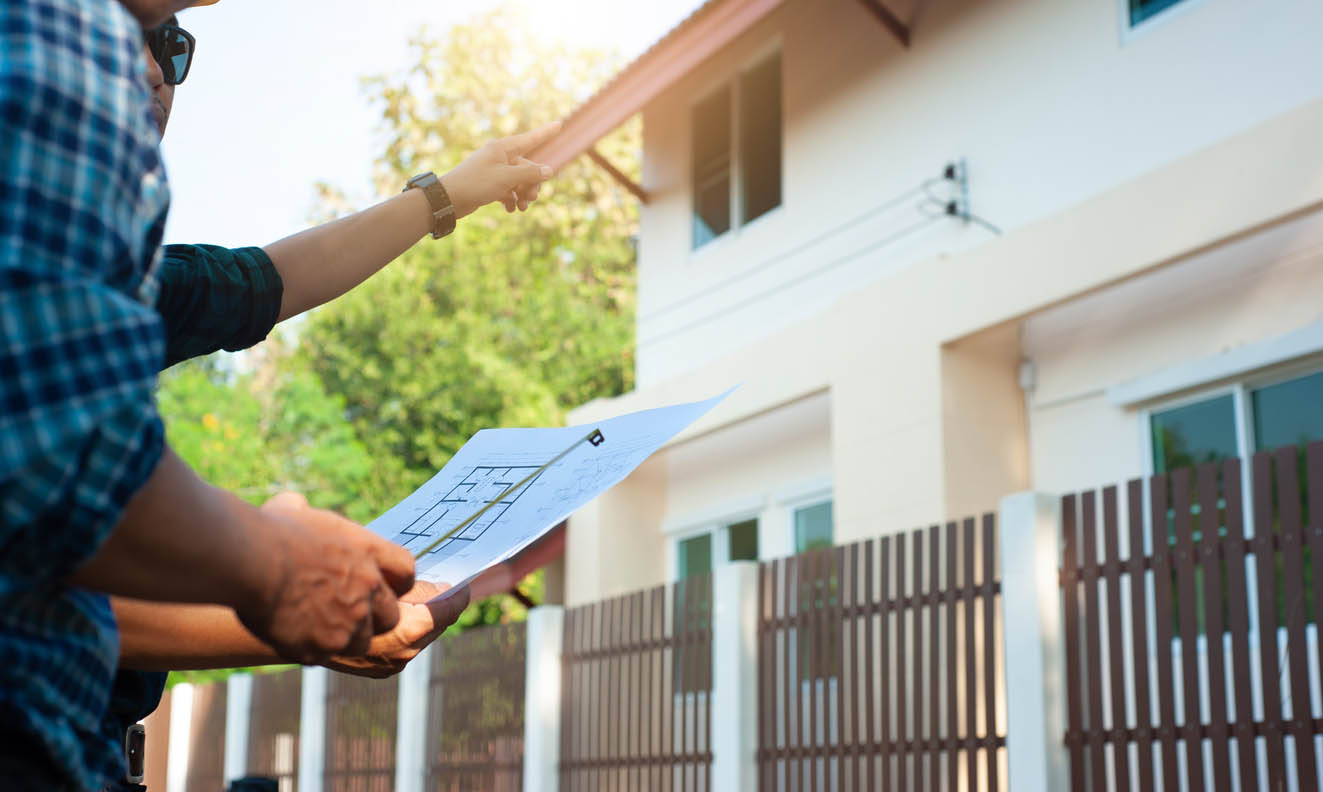
The Pros and Cons of House Flipping
House flipping is appealing, but it isn’t for everyone. Knowing the following pros and cons of house flipping can help someone decide if they should take the plunge into this form of real estate investing or not.
Pros:
- Potential for profit: Many people decide to flip houses because of how much money can be made in one flip. In fact, a successful home flip can put $40,000 to $70,000 in a flipper’s pocket, and often in less than 90 days.
- New acquired skills: As a house flipper, it’s impossible not to learn a wide variety of new skills. Not only can this be exciting, but newly gained knowledge can also make each subsequent flip easier and potentially more profitable. Through repairing, renovating, and remodeling, flippers can learn plenty about construction. In addition to learning the steps for different types of projects, house flippers learn how to budget and prepare for delays or other upsets. They can also learn the ins and outs of real estate sales, how to read a market, and how to spot a good investment. Diving into each skill is the best way to learn how to flip a house for the most profit possible.
- Wider network of professionals: A successful flip involves a lot of people, so flippers tend to grow very large networks. Contacts often include real estate agents, attorneys, insurance brokers, partner investors, and several contractors. Flippers also tend to know interior designers, house stagers, and even marketers who help them advertise their most recent flip.
- Personal satisfaction: As networks grow alongside a list of successful flips, a personal benefit of flipping houses is the feeling of pride and accomplishment a flipper can feel. Real estate flipping isn’t an easy business for everyone, so for those who do succeed, a pat on the back is well deserved.
Cons:
- Financial loss: Risk is the biggest potential pitfall of house flipping that keeps investors away, and it’s understandable. A best-case scenario for a failed flip is breaking even. But a worst-case scenario can leave a flipper facing a financial loss. And unfortunately, even the best budgeted and planned flip can take a sudden turn for the worse. Unanticipated expenses, market crashes, and tax increases can eat into a flipper’s revenue.
- Failure to sell: If a flipped home doesn’t sell quickly, everyday homeownership costs can be a concern. Carrying a mortgage, paying for taxes, and keeping up with insurance on a property are all required until it sells, and these costs can add up. Flippers also have to consider additional maintenance costs like landscaping or snow removal. The longer a home sits on the market after being flipped, the smaller the profit margins get.
- Concern and emotional hardship: Flipping isn’t for the faint of heart. While there is opportunity for reward, the emotional investment can prove to be too much for some. Between finding the right property, coming up with a budget, overseeing multiple projects, dealing with setbacks, and finding a potential buyer, some flippers decide to call it quits before making any real progress in the industry. For the best results, house flippers are encouraged to seek the help of professionals who can make their investment in house flipping worthwhile. While the opportunity for success is there, flipping a house will always have its challenges. A flipper who surrounds themselves with a successful team of experts will always be more likely to enjoy the pros of flipping and navigate more easily through any setbacks.
Flipping a House: DIY vs. Hiring Professionals
For those learning how to do a flip for the first time, a common question tends to pop up: Should they tackle a house flip on their own or spend the money to hire a professional?
House flippers, especially those just entering the business, may need to switch up their perspective on hiring contractors for their flip. Rather than viewing contractors as an extra cost or piece of the puzzle to manage, flippers will want to view these pros as assets to a house flipping project. Not only can they save the flipper money, but they can also help a flipper make a larger profit in the long run. There are several reasons for this.
First, there are resources to consider. Contractors bring along their own tools, teams, and knowledge. It can be expensive and time consuming for a flipper to get the equipment, man hours, and knowledge necessary for the project without it eating into their budget.
Next, there’s safety to consider. Professionals understand how to navigate dangerous jobs, whether they involve hazardous materials, electricity, or heavy-duty machinery. A novice may think paying a pro to save hours of labor will cut into their budget, but they might not take potential medical bills due to an accident into consideration. Aside from the personal risk, many home improvement projects actually require a professional to tackle them from a legal standpoint. This means that trying to save cash on a flip can result in penalties or fines.
Finally, flippers need to consider aesthetics when trying to cut contractors from their roster. Depending on their area of expertise, contractors have painted hundreds of walls, installed hundreds of pipes, or wired hundreds of outlets. They know not just how to do something but how to make it look good and function well. Home buyers notice these things, which means tackling too many projects on their own can leave flippers with no choice but to accept a lower offer from disappointed buyers or even worse, no offers at all.
While it’s technically true that contractors will raise the cost of a house flip, they also lend a hand in making sure projects stay on track, saving flippers from unnecessary costs caused by a lengthy project. They will make sure the job is done safely, protecting an inexperienced flipper from a disaster. And finally, they will ensure that everything works well and looks great at the same time. Home buyers notice a job well done and are therefore more willing to pay top dollar. This is why, while it’s certainly possible for a flipper to tackle a few minor DIY projects here and there on a flip, contractors will almost certainly be involved in the flipping process.
How to Save Money on the Cost to Flip a House
There’s no doubt that flipping a home can be an expensive undertaking. Luckily, there are plenty of tricks of the trade that veteran home flippers know to save costs where they can without compromising value or a home’s integrity. When budgeting a flip, keep the following cost-saving tips in mind.
- When in doubt about the purchase price, negotiate or move on. The purchase price is the most important variable in the flipping business since it can determine whether or not the purchaser can make a profit. Flippers can use tools or software to help organize renovation costs against purchase price and carrying costs. This can make it easier to determine whether a purchase price is a good deal.
- Always seek out multiple bids and negotiate when appropriate. It’s not uncommon for contractors to pad their estimates, so by taking the time to investigate average project costs, house flippers can feel confident that the price a contractor quotes them is fair and reasonable. By avoiding sloppy work and bloated estimates, flippers can substantially save on the cost of projects throughout a home.
- Shop at outlets and even salvage yards for materials. Flippers can save money by shopping for their own materials rather than relying on contractors to gather supplies. However, if the flipper is less focused on price and is shopping purely aesthetically, a contractor can often get cheaper prices than a flipper could shopping off the shelves of big- box stores.
- Flippers can reduce labor costs by taking on some of the demolition or cosmetic work themselves. Taking out cabinets, painting a few walls, and adding hardware without a contractor’s help (and labor costs) can add up to savings in the end.
- Make aesthetic choices without emotion. Flippers should remember that they are not the ones who will be living in a home and that choices shouldn’t be made on personal preference, but rather on budget and what will appeal to the masses.
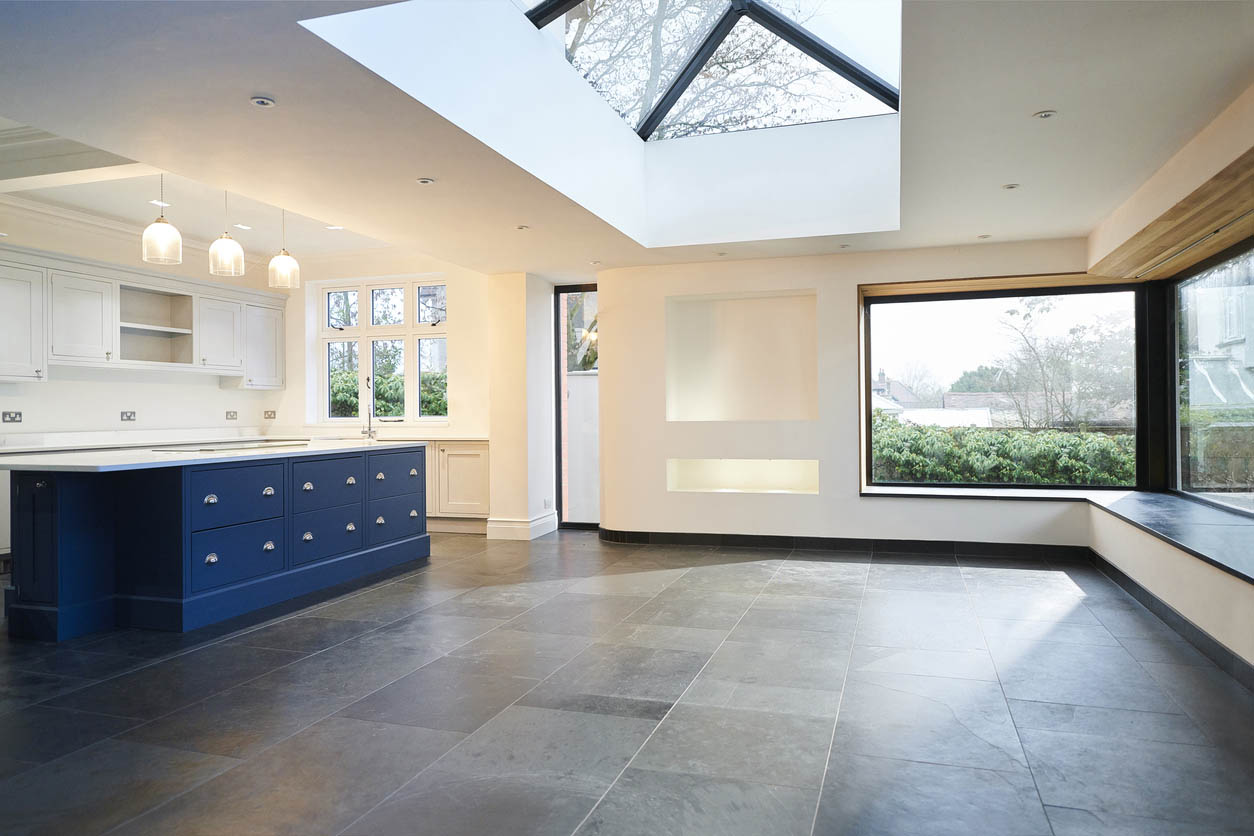
Questions to Ask About House Flipping
A house flipping project can involve a large team of contractors; one inexperienced or unqualified contractor can throw off an entire project. To ensure a team is made up of only the best contractors in their fields, house flippers can ask a combination of the following questions to every contractor being considered for a flip. Potential flippers will also want to keep in mind that reaching out to more than one contractor is recommended for every project.
- Are you licensed in your field?
- Do you have insurance for both you and your workers?
- How long have you been in business?
- How large is your team?
- How are your employees trained?
- What experience have you had with this type of project?
- Do you offer free quotes?
- Is prep and cleanup included in the cost?
- Do you have any references you can provide?
- Do you plan on using any subcontractors?
- Are there any warranties on materials or labor?
- When can you start on the project?
- How long will the project take?
- Is there any prep work I can do beforehand to ensure the project goes to plan?
- How do you handle payments?
- Do you require a down payment?
- What happens if unforeseen issues are uncovered during the project? How could this affect the timeline and cost?
- Will you be on-site daily, or do you have a project manager to oversee running jobs?
- Have you had any legal disputes from previous jobs?
- Will you research and handle any permit requirements?
- What happens if an issue with your work is discovered during the house inspection?
FAQs
How much does it cost to flip a house? Home renovation costs are different for every house, but house flipping can be a profitable business. While there are certainly risks involved, working with a variety of contractors is the best way to stay on track and within budget. For those still uncertain about the house flipping business, the following questions and answers may help guide them toward a decision.
Q. What is the profit on a house flip?
Popular house flipping shows don’t always accurately reflect profits in house flipping. So how much do house flippers actually make? It depends. In most cases, a house flipper should aim for a 10 percent to 20 percent profit of the home’s value after repairs, but this can vary depending on the market and the projects completed.
When gauging success, house flippers will likely consider a 10 percent profit to be a success, though on a lower scale. Pocketing a 20 percent profit is considered above an above-average percentage, which is typically achieved by luck with beginners or experience with veterans.
Q. Can you flip a house with $10,000?
Flipping a house with only $10,000 is possible, but it’s also a challenge. It’s a low amount of capital to get the job done. But with a little creativity, some luck, and a ton of elbow grease, it’s possible to transform a house for profit with only $10,000. House flippers with a lower budget should expect to do plenty of the work on their own, choose materials based on price over preference, and be selective with the projects that they consider essential in a flip.
Q. What is the 70 percent rule in house flipping?
The 70 percent rule helps home flippers determine the top price they can pay for an investment property without risking profit. The simple equation is a home’s after-repair value (ARV) multiplied by 70 percent; if an investment property can’t be secured at or below this number, there’s too little of a profit margin to take the risk on a flip.
It’s critical for potential flippers to remember that the 70 percent rule is just a general rule of thumb. There will always be exceptions to the rule, and being able to spot unique opportunities or red flags that cancel out the 70 percent rule takes experience.
Q. How many houses can I flip in a year?
There are several variables that affect the answer to the question, and the truth is that the number of homes an investor can flip in a year is dependent on each person’s own unique circumstances. Factors like finances, investment opportunities, and whether it’s a full-time job or a side gig all come into play. For reference though, the average full-time house flipper can renovate and sell between two and seven homes in a calendar year.
Q. Can you get rich flipping houses?
Absolutely! Flipping houses can be a wise and profitable investment. But that doesn’t mean the payoff is guaranteed, and it’s certainly not easy to achieve. The truth is that flipping houses is a risk, and the potential to break even or even go into debt is always on the table. That’s why it’s always recommended for a house flipper to work with an experienced team to raise the likelihood of success.
Q. How long does it take to flip a house?
Every flip’s timeline is unique, but house flippers typically spend a minimum of 6 to 12 weeks buying and flipping a home. But if any part of the process is delayed, a domino effect can quickly extend this timeline. It’s also not uncommon for larger projects to take several months to complete.
Sources: Angi, HomeAdvisor (1 and 2), HomeGuide, Forbes, Fit Small Business, New Silver
